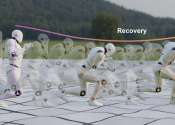A transformable robot with an omnidirectional wheel-leg
Researchers at Worcester Polytechnic Institute recently created OmniWheg, a robotic system that can adapt its configuration while navigating its surrounding environment, seamlessly changing from a wheeled to a legged robot. ...









